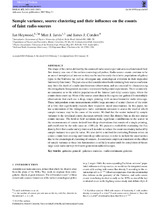| dc.contributor.author | Heywood, Ian | |
| dc.contributor.author | Jarvis, Matt | |
| dc.contributor.author | Condon, James J. | |
| dc.date.accessioned | 2017-07-26T07:16:02Z | |
| dc.date.available | 2017-07-26T07:16:02Z | |
| dc.date.issued | 2013 | |
| dc.identifier.citation | Heywood, I. et al. (2013). Sample variance, source clustering and their influence on the counts of faint radio sources. Monthly Notices of the Royal Astronomical Society, 432: 2625–2631 | en_US |
| dc.identifier.issn | 0035-8711 | |
| dc.identifier.uri | http://hdl.handle.net/10566/3108 | |
| dc.identifier.uri | http://dx.doi.org/10.1093/mnras/stt843 | |
| dc.description.abstract | The shape of the curves defined by the counts of radio sources per unit area as a function of their
flux density was one of the earliest cosmological probes. Radio source counts continue to be
an area of astrophysical interest as they can be used to study the relative populations of galaxy
types in the Universe (as well as investigate any cosmological evolution in their respective
luminosity functions). They are also a vital consideration for determining howsource confusion
may limit the depth of a radio interferometer observation, and are essential for characterizing
the extragalactic foregrounds in cosmicmicrowave background experiments. There is currently
no consensus as to the relative populations of the faintest (sub-mJy) source types, where the
counts show a turn-up. Most of the source count data in this regime are gathered from multiple
observations that each use a deep, single pointing with an interferometric radio telescope.
These independent count measurements exhibit large amounts of scatter (factors of the order
of a few) that significantly exceeds their respective stated uncertainties. In this paper, we
use a simulation of the extragalactic radio continuum emission to assess the level at which
sample variance may be the cause of the scatter. We find that the scatter induced by sample
variance in the simulated counts decreases towards lower flux density bins as the raw source
counts increase. The field-to-field variations make significant contributions to the scatter in
the measurements of counts derived from deep observations that consist of a single pointing,
and could even be the sole cause at >100 μJy. We present a method for evaluating the flux
density limit that a radio survey must reach in order to reduce the count uncertainty induced by
sample variance to a specific value. We also derive a method for correcting Poisson errors on
source counts from existing and future deep radio surveys in order to include the uncertainties
due to the cosmological clustering of sources. A conclusive empirical constraint on the effect
of sample variance at these low luminosities is unlikely to arise until the completion of future
large-scale radio surveys with next-generation radio telescopes. | en_US |
| dc.language.iso | en | en_US |
| dc.publisher | Oxford University Press | en_US |
| dc.rights | Copyright the Authors. Authors may archive the published version in their institutional repository. | |
| dc.source.uri | http://dx.doi.org/10.1093/mnras/stt843 | |
| dc.subject | Galaxies: general | en_US |
| dc.subject | Galaxies: statistics | en_US |
| dc.subject | Radio continuum: galaxies | en_US |
| dc.title | Sample variance, source clustering and their influence on the counts of faint radio sources | en_US |
| dc.type | Article | en_US |
| dc.description.accreditation | Web of Science | |

